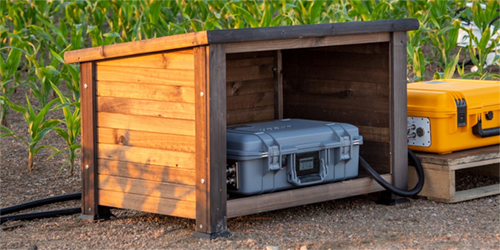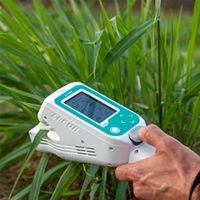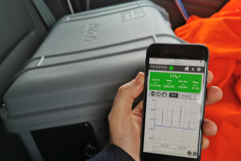
|
News and Updates from LI-COR
A few highlights in the May issue:
- Watch our webinar on N2O and other trace gas measurements
- See what leading scientists worldwide think of the new
Porometer/Fluorometer
- Find details about our new Aquatic Chamber that measures
photosynthesis of algae in suspension
- Sign up to be notified about the upcoming eddy covariance
book
- Check out our two-part webinar series on measuring urban
GHG emissions and concentrations
- Learn about new research into seagrass meadows and CO2
exchange between the air/water interface
|
|
Trace Gas Analysis
|
|
Webinar: Measuring N2O and Other Trace
Gases in Soil and Air Using LI-COR Trace Gas
Analyzers
The webinar "Measuring N2O and Other Trace Gases in Soil and Air
Using LI-COR Trace Gas Analyzers" introduces the LI-7820 N2O/H2O
Trace Gas Analyzer and its role in studying soil gas flux. Dr. Graham
Leggett describes the technology behind the trace gas analyzers
and applications that can benefit from these measurements – such
as soil gas flux, emission detection and quantification, long-term
monitoring, and mobile monitoring.
|
|
Watch the Recording
|
|
|

|
|
Plant Physiology
|
|
|
LI-600 Experiences
|
|
Dr. Nathan Lemoine won a trial of the LI-600 Porometer/Fluorometer
– and he used it to expand his capability to collect measurements of
an invasive North America plant.
By combining the speed of the new LI-600 with the details from
the LI-6800 Portable Photosynthesis System, Dr. Lemoine acquired
s ecophysiological data with both breadth and depth.
|
|
Read The Story
|
|
|
 |
Win your own free
trial of an LI-600.
Enter for the chance to field
test the LI-600 and see
firsthand why we love it.
Sign Up Now
|
|
|
Measuring Aquatic Photosynthesis
A WEBINAR ON USING THE AQUATIC CHAMBER
|
|
Check out the recording of our webinar, "A Novel Approach to
Measuring Carbon Assimilation and Chlorophyll a Fluorescence in
Algal Suspensions," to find out how researchers are using our new
Aquatic Chamber. LI-COR scientists and a research team from the
University of Essex introduce the theory behind the LI-6800-18
Aquatic Chamber, describe the principles of the measurement,
and provide examples of actual measurements.
|
|
|
|
Watch the Recording
|
|
|
|
Eddy Covariance
|
|
|
Updated Eddy Covariance Book
|
|
Dr. George Burba’s book, “Eddy Covariance Method for Scientific,
Industrial, Agricultural, and Regulatory Applications,” is updated with
the latest information on eddy covariance flux measurements. The
updated edition features improved workflow descriptions and
reviews of the latest developments
Be one of the first know to when the updated edition copy is
released in Summer 2021!
|
|
|
|
Sign Up Now
|
Urban Eddy Covariance Monitoring Webinars
PART 1: DIRECT MEASUREMENTS OF GAS EMISSIONS
|
|
Eddy covariance measurements of urban emissions can provide
higher resolution data with better precision than proxy estimates and
indirect measurements. For example, direct eddy covariance
measurements can help determine if efforts to reduce emissions are
effective by quantifying the change over time. They can guide
planning to optimize the effectiveness of these efforts. This
information may also be useful for urban planning, zoning,
transportation decisions, policies, regulations, and safety for urban
development at local and national levels.
In this webinar, we describe how to use flux measurements in these
applications.
Presenters:
Dr. George Burba
Fellow
LI-COR Biosciences
Dave Johnson
Senior Field Application Scientist
LI-COR Biosciences
|
|
|
|
Watch the Recording
|
PART 2: STATIONARY CONCENTRATION MEASUREMENTS
AND MOBILE MONITORING
|
|
In part 2 of the series, we will focus on how individuals are taking
stationary concentration measurements and mobile applications for
analyzers and how that information has been used by researchers to
address city impact on greenhouse gas emissions. We describe how
stationary concentration measurements and mobile monitoring can
be used to provide real data that can lead to actionable insights. For
example, concentration measurements can help plan effective
emission reduction efforts and can be used to measure the results of
local emission reduction activities. Similar to direct emission
measurements, concentration measurements can be useful for urban
development at local and national levels.
Presenters:
Dr. George Burba
Fellow
LI-COR Biosciences
Dr. Joseph von Fischer
Professor and Associate Chair of Biology
Colorado State University
Dave Johnson
Senior Field Application Scientist
LI-COR Biosciences
Dr. Graham Leggett
Sr Scientist
LI-COR Biosciences:
|
|
|
June 16th, 2021
10:00 AM CDT
8:00 PM CDT
|
 |
|
Sign Up Now
|
New Research on Air/Water CO2 Exchange and
Seagrass
|
|
Dr. Bruce Van Dam and associates have published exciting new
results exploring the ability of seagrass meadows to capture and
store atmospheric CO2 gas through the air-water interface.
Unsurprisingly, it’s complicated. Dr. Van Dam, who is with the
Institute of Carbon Cycles, Helmholtz‐Zentrum Hereon, Geesthacht,
Germany, combined existing data from published literature with
direct measurements to parse some of the complexity into
components that contribute to this process. This research presents
compelling results while identifying areas where additional research
is needed.
|
|
Read the Paper
|
|
|
|
Training
|
Eddy Covariance Training
14-16 Sep
Lincoln, NE - USA
5-7 Oct
Online - EU
|
|
Register
|
Photosynthesis Training
7-11 Jun
Lincoln, NE - USA
LEEF Training
24-25 Aug
Online - USA
7-8 Sep
Online - EU
21-23 Sep
Lincoln, NE - USA
12-13 Oct
Lincoln, NE - USA
16-17 Nov
Lincoln, NE - USA
7-9 Dec
Lincoln, NE - USA
|
|
Register
|